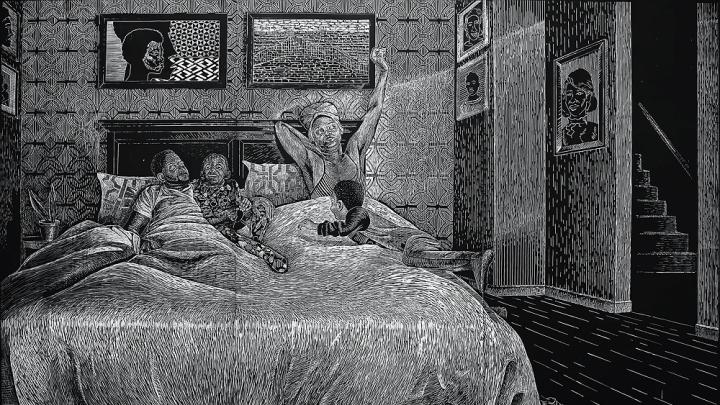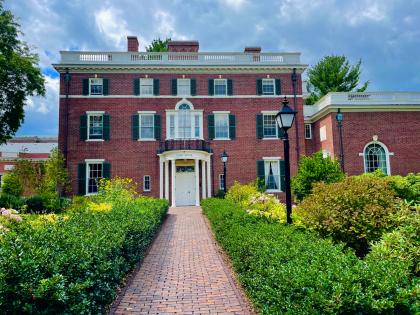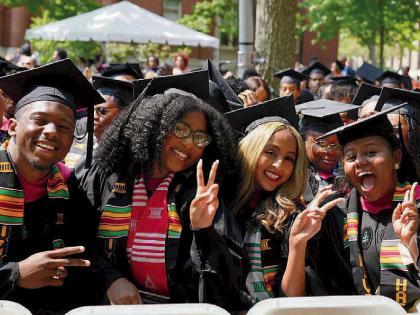In a new exhibit at the Harvard Art Museums, “LaToya M. Hobbs: It’s Time” (on view until July 21), the painter and printmaker LaToya M. Hobbs challenges the assumption that motherhood and artistry are inherently at odds. The centerpiece of the exhibition is “Carving Out Time,” a life-sized suite of woodblock prints depicting a typical day in the artist’s life with her husband and two children. The phrase “carving out time” usually suggests protecting time for a specific activity amid the demands of daily life—a usage that reinforces the perceived dichotomy between motherhood and creativity. But Hobbs takes the expression more literally. To make these works, she carved images into a wood block, then inked and printed them. She depicts the moments she spent folding laundry, teaching her children, making dinner, and painting in her studio all as art. One role is not more important than the other; all are inextricably linked.
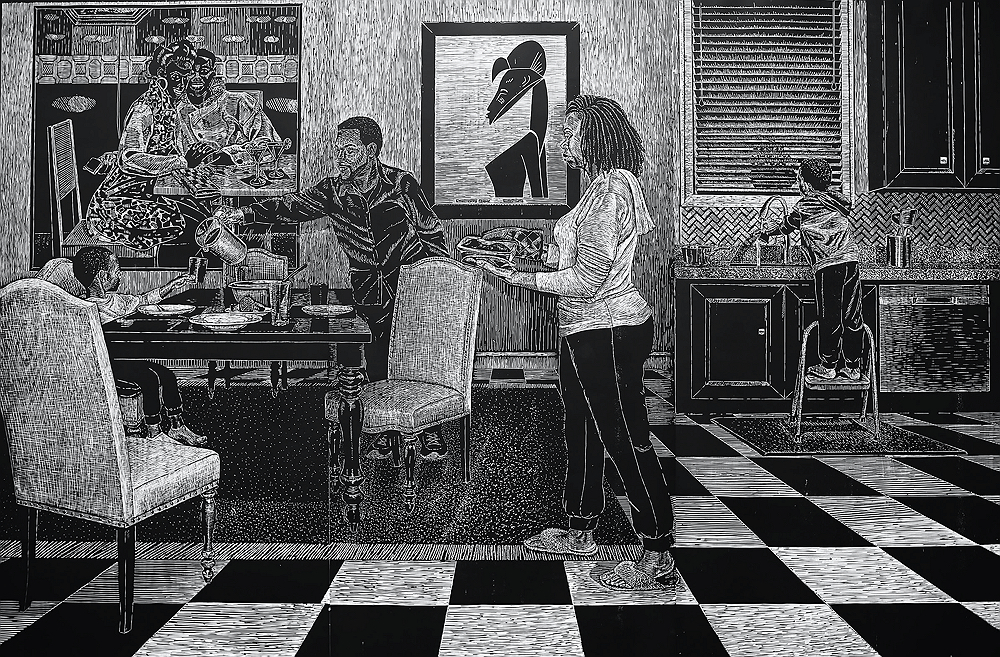
The Harvard Art Museums purchased the prints in 2022 in a “major, monumental acquisition,” Elizabeth M. Rudy, Weyerhaeuser curator of prints, said at a preview of the show. The exhibition also includes preparatory drawings lent by Hobbs to the museums and video taken by her husband, the artist Ariston Jacks, that depicts the printmaking process. “This acquisition was transformative, both for the museums’ holdings of contemporary art and for its representation of monumental prints in the long history of printmaking,” Rudy said in a press release. Rudy worked with graduate students and colleagues at the museums to develop the exhibit, and with the Association of Black Harvard Women to design programming that will take place throughout the spring and summer, including poetry readings and print-making workshops.
Carving Out Time: Salt of the Earth Series
“Carving Out Time” is part of Hobbs’s continuing “Salt of the Earth” series, which consists of portraits of black women. The Arkansas-born and Baltimore-based artist has displayed her work in venues including Baltimore City Hall and the Virginia Museum of Contemporary Art. This spring, her work—including the original “Carving Out Time” woodblocks—will also be displayed at the Frist Art Museum in Nashville. “There are not enough depictions of women just as we are,” Hobbs said in a 2019 interview about the “Salt of the Earth” series, as opposed to representations that rely on stereotypes and tropes. In “Carving Out Time,” Hobbs continues her attempts to capture women as they are, women in everyday moments—this time extending the work to herself.
The exhibit displays the five prints of “Carving Out Time” from left to right in chronological order. The first, “Morning,” depicts Hobbs and her family waking up, her two children crawling into bed as she stretches, sunlight streaming in from the right. The fourth, “Bedtime for the Boys,” is a similarly sentimental image, depicting Hobbs reading to one of her children as her husband plays on the floor with the other. But she also portrays the mundane, tedious work involved in raising children. In the second print, “Homeschool and Housework,” she sits twisted on a chair, one hand folding laundry, the other reaching over to help her son with online school. In the fourth, “Dinner Time,” she carries a meal to the family’s table. She’s not smiling, as one might expect of a romanticized image of motherhood; her resting expression remains true to life.
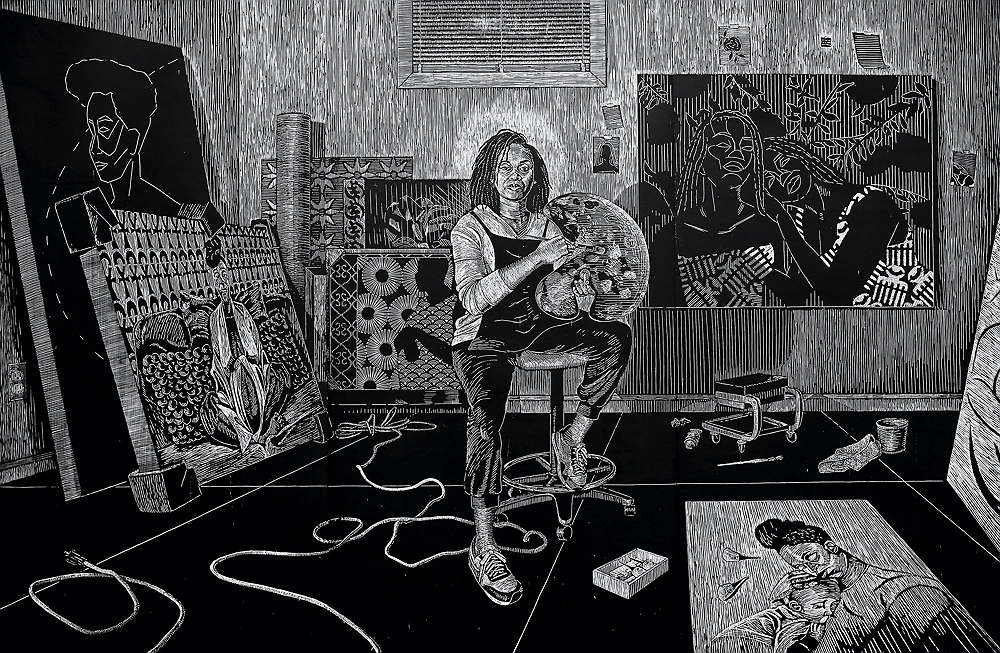
Artistic Depictions of Motherhood
The prints also include allusions to artworks that have influenced Hobbs. In “Homeschool and Housework,” the sculpture “Seated Woman” by Elizabeth Catlett sits atop a bookshelf, mirroring Hobbs’s own posture. In “Dinner Time,” Kerry James Marshall’s painting “Untitled (Club Couple)” hangs on the wall; the two smiling figures, dressed up and drinking martinis, stand in contrast to Hobbs and her husband’s more mundane mealtime. Additional works by artists such as Margaret Taylor-Burroughs, Valerie Maynard, and Jean-Michel Basquiat also appear in the prints. Visitors to the exhibit can scan a QR code to identify and explore further details about these original artworks.
The final print of the series, “The Studio,” depicts Hobbs alone in her studio at the end of the day. A subtle halo of light surrounds her head; she stares directly at the viewer. Here, Hobbs draws inspiration from art historical traditions not only in her recreations of artworks, but also in the construction of the image. Her decision to include a halo was “reflective of my art history training—[what I studied] was a lot of white people with haloes,” Hobbs said at the show preview. “When I started to do my own portrait work, for me [the halo] became a symbol of the righteousness of the people in my community, and my own spirituality.”
The prints, 8-by-12 feet, are at once overwhelming in size and startingly intimate in their portrayal of the artist’s personal life. Like Hobbs herself—artist, mother, educator, wife—her images are many things at once: monumental in scale yet narrow in focus, depicting universal experiences that are grounded in the individual.
